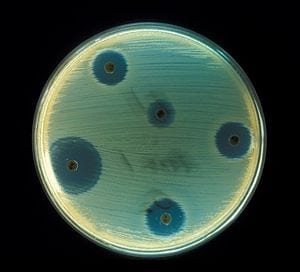
Tests with the first prototypes at the Barth shipyard were promising
Special underwater coatings prevent shells and other organisms from growing on the hull of ships – but biocide paints are ecologically harmful. Together with the industry, researchers have developed more environmentally-friendly alternatives.
If a ship is at anchor for longer periods algae, shells and barnacles will colonize it. Every year, this so-called biofouling causes economic losses of billions of Dollar. Biological growth on the underwater surface promotes corrosion. The deposits increase the roughness of the hull below the waterline which has a braking effect as the ship travels. Depending on the roughness of the basified bio layer, the consumption of fuel can increase by up to 40 percent. In the case of a large container ship this can result in additional annual costs of several millions.
All the countermeasures used to date have considerable drawbacks: Cleaning the hull by sandblasting in a dry dock removes also the painted coating and can only be used every three to five years. There are effective hull coatings preventing the growing of adhering bio layers, but in most cases by ecotoxic biocides. Both copper ions and synthetic biocides accumulate in the coastal water and in the sediments. For this reason the particularly toxic tributyltin (TBT) is banned since 2008 and the currently preferred and still permitted copper oxide containing coatings are to be replaced by non-toxic alternatives in the foreseeable future.
As part of the BMWi-supported project consortium “Controlled Antifouling System based on Nanocomposits for Shipping“ (GANaS) researchers at the Fraunhofer Institute for Mechanics of Materials (IWM) in Halle have developed a more ecologically-friendly alternative. “The electrochemically active coating system produces regularly changing pH values on the surface of the hull. This effectively prevents colonization without having to use any biocides“, explains Professor Manfred Füting of the IWM in Halle who is coordinating the project.
Painted coatings as electrodes
Large area electrodes were painted on an isolating primer coating. The electrochemical active layer based on a sol-gel paint of NTC (nano tech coating gmbH), which was modified by electrically conductive particles. To achieve an adequate distribution of the electrolysis current a highly conductive interlayer was applied. In a preprogrammed and optimized electrochemical process the electrolysis current is periodically commutated and interrupted. A current density of lower than 0,2 mAcm-2 generates enough pH stress near the surface of the hull to prevent the growing on of any barnacles, shells and algae The electric current is supplied by a photovoltaic module or by the land based power grid.
via Fraunhofer
The Latest Streaming News: Keeping ship hulls free of marine organisms updated minute-by-minute
Bookmark this page and come back often
Latest NEWS
Latest VIDEO








